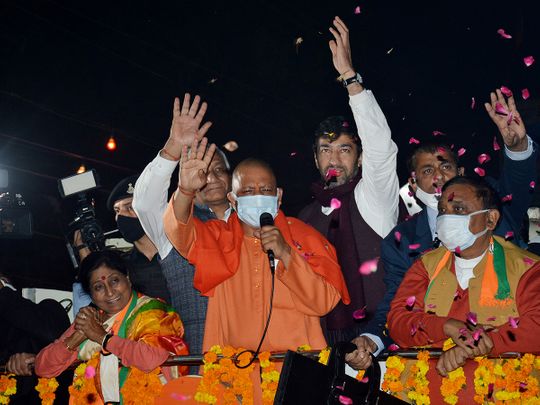
Five years back, the Bharatiya Janata Party (BJP) swept the 2017 Uttar Pradesh assembly polls with a stunning victory. It won 312 seats in the 403 House, garnering 39.67% of the votes. The Samajwadi Party (SP), led by Akhilesh Yadav, came a poor second.
It won only 47 seats, down 177 from its previous tally of 224. Its vote share also reduced substantially to just under 22%. Mayavati’s Bahujan Samaj Party (BSP) came third, with a higher vote share than SP, but only 19 seats in its kitty. The once-mighty Congress bit the dust with only 7 seats.
What made the BJP’s success so significant is that it recorded a 24.67% swing of the voting share in its favour. The BSP, despite its steady support base, could not convert it into actual seats. It lost 61 seats from its previous tally of 80.
In a three-cornered contest, the opposition gets fragmented, with the winning party usually the beneficiary. The voter turnout was 61.24% voter, an increase of 1.84% from the 2012 elections. So, no one could say that the BJP won because fewer people showed up or exercised their franchise.
When we consider the opinion polls before the 2017 elections, one fact emerges loud and clear. They were all wrong. By a huge margin. In fact, no poll gave the BJP more than 202 seats, the number projected by Times Now-VMR.
The average of over ten major polls shows the BJP running neck-to-neck with 157 to the SP-Congress Alliance’s 153. The exit polls were slightly better, giving the BJP 228 and 144 to SP-Congress. The actual results were so different, with the NDA alliance led by the BJP scoring nearly 100 seats more and the SP-Congress 100 seats less.
Why was everyone so wrong? That is because both pollsters and experts alike failed to see that tremendous anti-incumbency and dissatisfaction on the ground. Also, they totally underestimated the appeal of Yogi Adityanath. Coming from nowhere into the UP assembly elections, he sprinted to the finish line so way ahead of his competitors that it took the whole nation by surprise.
This needn’t have been the case. Adityanath’s record as a five-time Lok Sabha member from Gorakhpur meant that he had considerable clout and following. Occupying the same seat in Parliament for nearly twenty-five years is no joke. But both the media and the psephologists had not taken him seriously.
Why? Because he was saffron-clad Hindu monk, an unprecedented, if not unquantifiable, figure in Indian politics. His position and role were so unusual that observers and experts were flummoxed.
The English-speaking media houses were particularly confounded, even hostile, to his rise. UP in 2017 was like a semi-final to the general elections of 2019, which returned Narendra Modi to power as India’s prime minister for his second term.
This time, too, the state elections announced in seven phases from February 10 to March 7 will offer a foretaste of what will happen at the national level in 2024. It would be obvious to state that UP is crucial to BJP’s remaining in power. It is equally obvious that Yogi Adityanath occupies pole position in the forthcoming contest.

In less than five years as UP’s chief minister, his stature has only grown, not only in his own state, but across the country. He is easily one of the most recognisable, powerful, and popular leaders of the land. If he returns to power for a second term as UP’s CM, he will be the first one to do so in nearly fifty years.
But the fact is that in UP anti-incumbency is usually very high. Given its complicated caste and class calculus, not to mention politics of religion and region, few governments have succeeded in delivering either on the elections promises or on good governance. Usually, it is five years of filling the coffers of one party, clan, family, and cronies. This is where Adityanath scores over his rivals. Moreover, as a monk, he has no family, nor any personal interests to bolster or buttress.
No-nonsense leader
His image of a solid, clean, no-nonsense leader has won him admirers from all sections of society. The slew of developmental projects, including nearly 20,000 kilometres of roads in the state, have earned him and his party a good name.
Above all, the improved law-and-order situation in UP has inspired confidence of the middle classes. In times of uncertainty and crisis, such as the ongoing Covid-19 pandemic, the most important need of the hour is a strong and stable leadership. That is exactly what Adityanath offers.
Given these facts, no one should be surprised if the BJP does well in these polls as well. Even if the numbers are a little less this time, it is highly unlikely that Akhilesh Yadav’s SP poses a serious threat. The recent defections of OBC leaders such as Swami Prasad Maurya and Dara Singh Chauhan, from the BJP to SP notwithstanding.
The truth is that these individual switchovers do not matter much in the bigger picture. Turncoats are seldom respected in Indian politics.
What is more, the BJP caste arithmetic has ensured that OBC candidates abound in the announcement of seats. High-profile defections from the other side, such as Mulayam Singh Yadav’s own daughter-in-law, Aparna Yadav, from SP to BJP will also offset or add spice to the defection drama so common before a major election. It is expected of disgruntled elements from either side to jockey for better positions whenever there is a political realignment.
This leaves us with the farmers’ stir, whose maximum impact would be felt in Western UP. Again, by yielding to their demands, the BJP has tried to blunt its negative fallout. Does this mean that the BJP is home and dry? No. Politics is a game of chance and uncertainties.
Anything can happen between now and March 10, when the results are expected to be announced. The Omicron wave of Covid-19 has already imposed curbs on campaigning and mass gatherings. Adityanath’s decision to contest from his home turf, Gorakhpur, rather than Ayodhya also shows that both he and the BJP are playing it safe.
In a straight contest between BJP and SP, the party in power doesn’t want to take unnecessary risks.











